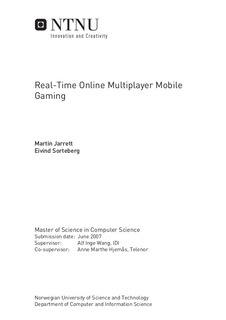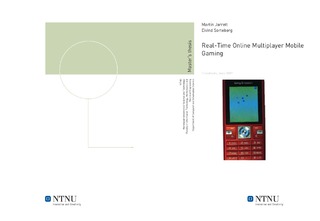| dc.description.abstract | Gaming on mobile phones is a business with a great growth potential both in profit and popularity. In today's modern world, the number of potential users of online multiplayer mobile games is enormous. This is because of the wide deployment of mobile phones and the increasing general interest in gaming. For game developers, this is an interesting business area, since mobile games are faster and easier to develop than console or computer games, due to the mobile games' smaller size and reduced complexity. Telecom companies, on the other hand, may profit from this both by attracting users through exclusive contents only available to their subscribers, and trough the potential network traffic generated by online multiplayer games. Some multiplayer mobile games are available on the market today. However, few of these can be played real-time, which often involves a more entertaining and attractive gameplay compared to slower, turn-based games. This project has focused on two main areas. Firstly, different network technologies and transport protocols have been tested to evaluate whether these are suitable for real-time multiplayer mobile games or not. This was done by testing the different networks' response times and transfer speeds. Secondly, a framework for developing this kind of games has been developed. Also, a game prototype has been implemented based on this framework, and the experience from this development has been recorded to provide assistance for future development projects within the same scope. The results from the tests show that, among the widely available mobile networks today, only UMTS (3G) and EDGE offer performance sufficient for a fast and stable real-time multiplayer mobile game. GPRS is too slow and unstable, and using this technology for real-time game communication is likely to lead to lags and an incoherent gameplay. Furthermore, the tests have clearly shown that UDP is far better suited for in-game communication than TCP, because of UDP's superior response time. For developers of such games, there are several challenges that have to be closely considered. Synchronization of clients is a very difficult task because of high network latencies. Furthermore, mobile phones are weak in terms of available resources. Managing these problems requires distribution of calculations and efficient algorithms. The game framework developed in this project has proved to provide a good basis for developing different game concepts within real-time multiplayer mobile gaming. Common functionality for such games is implemented in the framework, thus helping game developers avoid having to reinvent the wheel. This project has shown that successful real-time multiplayer mobile games are definitely possible to implement. However, doing this is a great challenge, both for developers, distributors, and telecom companies offering such games to their subscribers. A middle way has to be found between the complexity of the game, the need for frequent network updates, and the user cost involved with playing the game. If this middle way is found, it is very likely that such a game could be a great success. | nb_NO |

